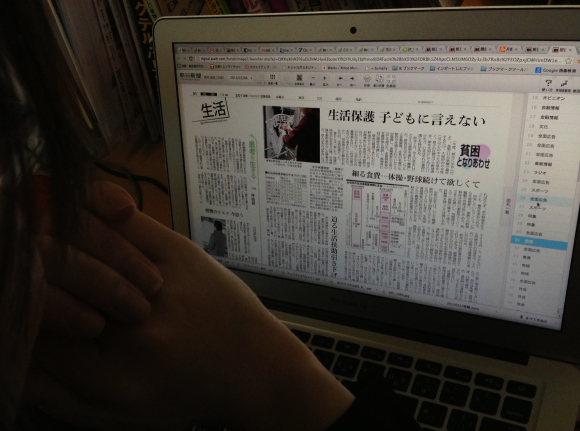
On March 6, the Osaka edition of the Asahi Shinbun published an article which featured a single mother of two from Japan who was in receipt of a 290,000 yen (about $3,000) monthly social security allowance. Despite this hefty amount of cash arriving in her bank account each month, though, she was alarmed to hear that her benefits may be cut in the near future.
In an interview with the paper, the woman said:
“I realise that asking for an increase in allowance is quite out of the question, but even with living as it currently stands, there are a lot of financial pressures that we’re subject to as a family. The last thing I want to do is create an inferiority complex in my children about their upbringing. The kids have got a hearty appetite and naturally want to eat. If the allowance sees any further cuts, I’ll have no alternative but to cut down on my own food expenditures.”
Well, taking this all on face value one might be inclined to be sympathetic towards the woman’s plight. Barely being able to cover the costs of living, and with a further cut on the horizon forsaking herself for her children, deserves nothing less than admiration. However, the mother seems to have omitted a few important details.
The article also listed a breakdown of the woman’s monthly outgoings. Just taking a glimpse at the finer details, you’d be forgiven for wondering whether this woman has got her priorities in the correct order.
Below is the actual breakdown of the woman’s monthly benefits (conversions in US dollars):
Housing assistance: 54,000 yen ($560)
Livelihood assistance: 219,580 yen ($2,300)
Education assistance: 19,000 yen ($200)
Total: 292,580 yen ($3,060)
And here’s what she actually uses this allowance for:
Rent: 54,000 yen ($560)
Food expenses: 4,300 yen ($45)
Electricity: 5,200 yen ($54)
Gas expenses: 8,300 yen ($90)
Water supply costs: 0
Mobile phone costs: 26,000 yen ($270)
Landline phone costs: 2,000 yen ($20)
Afternoon snacks: 7,000 yen ($70)
Dining out: 2,000 yen ($20)
Daily necessities: 37,000 yen ($385)
Oil stove: 4,000 yen ($40)
Travel expenses: 1,000 yen ($10)
Medical costs (Over the counter medicine): 2,700 yen ($30)
Clothing expenses: 20,000 yen ($210)
Socializing expenses: 11,000 yen ($115)
Entertainment/tuition course expenses (mostly children’s tutorial fees): 40,000 yen ($415)
School related expenses: 1,3000 yen ($135)
Other: 15,380 yen ($160)
Upon seeing this breakdown, some of the reactions from net users included:
“Is the fixed line phone really that necessary?”
“The mobile phone bill is way too expensive!”
“Even a working household doesn’t spend 40,000 yen on education fees”
“That type of allowance is ridiculous!”
Admittedly, observing the above breakdown, it becomes evident that there are some unnecessary expenditures going on here, and one might argue that, before cutting down on food expenses, how about practicing a little more self-control on the phone bill and entertainment expenses? Arguably achieving this would create a large amount of financial freedom.
If these figures are representative of the actual allowance this woman receives each month, it wouldn’t be an understatement to say that she lives a more luxurious life than many people in full time-employment. However, one can’t help but question the assessment measures put in place by the government when paying out such hefty sums.
To put all this in perspective, it is perhaps necessary to refer to the fundamental principles of the Japanese livelihood protection system (social welfare system) and the reason for its existence:
“The livelihood protection system is devised by the country to assist citizens undergoing financial distress by guaranteeing a minimum standard of living, whilst helping to establish self-independence.” (Livelihood Protection Law Clause 1, Chapter 1)
It is evident that this is a system designed for the poverty-stricken, or those at a social disadvantage, looking for a way to establish a foothold in working society. As it currently stands, there are particular elements of the Japanese social welfare system that are perhaps too lenient, creating a situation where one finds themselves questioning the need to work. Even if finding employment isn’t a problem, the salary is sometimes less than the livelihood protection allowance, which subsequently dampens the spirits and motivation to find work for many. Whether the allowance criteria is too relaxed or the employment initiative not effective enough, there looks to be quite some room for improvement within the current system as it stands.
Inset image: photolibrary.jp
[ Read in Japanese ]

 Is 150,000 yen (US$1,389) a month enough to live on in Tokyo? Depends what kind of life you want
Is 150,000 yen (US$1,389) a month enough to live on in Tokyo? Depends what kind of life you want Osaka welfare clerk denies application, suggests woman seek work in the sex industry
Osaka welfare clerk denies application, suggests woman seek work in the sex industry How much money do you need to live in your own apartment in Japan?【Survey】
How much money do you need to live in your own apartment in Japan?【Survey】 Kyoto families angered by new policy forcing high school students to buy tablets at own expense
Kyoto families angered by new policy forcing high school students to buy tablets at own expense Osaka woman gives foreigner Uber Eats worker fake money, thought he wouldn’t know difference
Osaka woman gives foreigner Uber Eats worker fake money, thought he wouldn’t know difference Disney princesses get official manga makeovers for Manga Princess Cafe opening in Tokyo
Disney princesses get official manga makeovers for Manga Princess Cafe opening in Tokyo Randomly running into a great sushi lunch like this is one of the best things about eating in Tokyo
Randomly running into a great sushi lunch like this is one of the best things about eating in Tokyo Beautiful new Final Fantasy T-shirt collection on the way from Uniqlo【Photos】
Beautiful new Final Fantasy T-shirt collection on the way from Uniqlo【Photos】 Is the new Shinkansen Train Desk ticket worth it?
Is the new Shinkansen Train Desk ticket worth it? Kyushu-exclusive Black Mont Blanc goes nationwide in a “Special” way
Kyushu-exclusive Black Mont Blanc goes nationwide in a “Special” way Hey, Japanese taxi driver! Take us to your favorite restaurant in Tsuruga City!
Hey, Japanese taxi driver! Take us to your favorite restaurant in Tsuruga City! Japanese black curry “experiment” takes place at an unlikely restaurant branch in Tokyo
Japanese black curry “experiment” takes place at an unlikely restaurant branch in Tokyo This themed Starbucks in Seoul is hidden away in possibly the coolest location ever
This themed Starbucks in Seoul is hidden away in possibly the coolest location ever How to make an epic pizza at a Japanese family restaurant
How to make an epic pizza at a Japanese family restaurant Beautiful new luxury train for Ishikawa dazzles with gold leaf and lacquer interior
Beautiful new luxury train for Ishikawa dazzles with gold leaf and lacquer interior Our Japanese reporter visits Costco in the U.S., finds super American and very Japanese things
Our Japanese reporter visits Costco in the U.S., finds super American and very Japanese things New Studio Ghibli bedding sets are cool in all senses of the word
New Studio Ghibli bedding sets are cool in all senses of the word We try out “Chan Ramen”, an underground type of ramen popular in the ramen community
We try out “Chan Ramen”, an underground type of ramen popular in the ramen community New Pokémon cakes let you eat your way through Pikachu and all the Eevee evolutions
New Pokémon cakes let you eat your way through Pikachu and all the Eevee evolutions There’s a park inside Japan where you can also see Japan inside the park
There’s a park inside Japan where you can also see Japan inside the park Japanese convenience store packs a whole bento into an onigiri rice ball
Japanese convenience store packs a whole bento into an onigiri rice ball New definition of “Japanese whiskey” goes into effect to prevent fakes from fooling overseas buyers
New definition of “Japanese whiskey” goes into effect to prevent fakes from fooling overseas buyers Foreign English teachers in Japan pick their favorite Japanese-language phrases【Survey】
Foreign English teachers in Japan pick their favorite Japanese-language phrases【Survey】 Uniqlo opens its first Furugi Project secondhand clothing pop-up shop in Tokyo
Uniqlo opens its first Furugi Project secondhand clothing pop-up shop in Tokyo Studio Ghibli releases Kiki’s Delivery Service chocolate cake pouches in Japan
Studio Ghibli releases Kiki’s Delivery Service chocolate cake pouches in Japan Japan’s bone-breaking and record-breaking roller coaster is permanently shutting down
Japan’s bone-breaking and record-breaking roller coaster is permanently shutting down Toyota built a life-sized Miraidon Pokémon and are letting people test drive it this weekend
Toyota built a life-sized Miraidon Pokémon and are letting people test drive it this weekend Foreign passenger shoves conductor on one of the last full runs for Japan’s Thunderbird train
Foreign passenger shoves conductor on one of the last full runs for Japan’s Thunderbird train Kyoto bans tourists from geisha alleys in Gion, with fines for those who don’t follow rules
Kyoto bans tourists from geisha alleys in Gion, with fines for those who don’t follow rules Studio Ghibli unveils Mother’s Day gift set that captures the love in My Neighbour Totoro
Studio Ghibli unveils Mother’s Day gift set that captures the love in My Neighbour Totoro Domino’s Japan now sells…pizza ears?
Domino’s Japan now sells…pizza ears? New Japanese KitKat flavour stars Sanrio characters, including Hello Kitty
New Japanese KitKat flavour stars Sanrio characters, including Hello Kitty Sales of Japan’s most convenient train ticket/shopping payment cards suspended indefinitely
Sales of Japan’s most convenient train ticket/shopping payment cards suspended indefinitely Sold-out Studio Ghibli desktop humidifiers are back so Totoro can help you through the dry season
Sold-out Studio Ghibli desktop humidifiers are back so Totoro can help you through the dry season Japanese government to make first change to romanization spelling rules since the 1950s
Japanese government to make first change to romanization spelling rules since the 1950s Ghibli founders Toshio Suzuki and Hayao Miyazaki contribute to Japanese whisky Totoro label design
Ghibli founders Toshio Suzuki and Hayao Miyazaki contribute to Japanese whisky Totoro label design Doraemon found buried at sea as scene from 1993 anime becomes real life【Photos】
Doraemon found buried at sea as scene from 1993 anime becomes real life【Photos】 Tokyo’s most famous Starbucks is closed
Tokyo’s most famous Starbucks is closed One Piece characters’ nationalities revealed, but fans have mixed opinions
One Piece characters’ nationalities revealed, but fans have mixed opinions We asked a Uniqlo employee what four things we should buy and their suggestions didn’t disappoint
We asked a Uniqlo employee what four things we should buy and their suggestions didn’t disappoint Princesses, fruits, and blacksmiths: Study reveals the 30 most unusual family names in Japan
Princesses, fruits, and blacksmiths: Study reveals the 30 most unusual family names in Japan Studio Ghibli’s new desktop Howl’s Moving Castle will take your stationery on an adventure
Studio Ghibli’s new desktop Howl’s Moving Castle will take your stationery on an adventure Japanese idol singers selling personal phone calls to fans who want to skip the singing
Japanese idol singers selling personal phone calls to fans who want to skip the singing Saitama welfare official threatened into giving out executive-level-salary worth of benefits
Saitama welfare official threatened into giving out executive-level-salary worth of benefits Tattooed Japanese woman suing nursing school after being suspended because of her ink
Tattooed Japanese woman suing nursing school after being suspended because of her ink iPhone gets stolen in Spain, Japanese owner gets hit with massive bill for $9,800
iPhone gets stolen in Spain, Japanese owner gets hit with massive bill for $9,800 Fake yakuza arrested in Tokyo after threatening man who was walking while staring at a smartphone
Fake yakuza arrested in Tokyo after threatening man who was walking while staring at a smartphone New sun protection mask becomes popular in Japan
New sun protection mask becomes popular in Japan New program lets you rent a house in a coastal Japanese town for less than 200 bucks a month
New program lets you rent a house in a coastal Japanese town for less than 200 bucks a month Kyoto bans tourists from geisha alleys in Gion, with fines for those who don’t follow rules
Kyoto bans tourists from geisha alleys in Gion, with fines for those who don’t follow rules Survey finds roughly one in four all-night Internet cafe customers in Tokyo is homeless
Survey finds roughly one in four all-night Internet cafe customers in Tokyo is homeless Man revives woman with AED, branded a “pervert” for removing her clothes to apply electrode pads
Man revives woman with AED, branded a “pervert” for removing her clothes to apply electrode pads “Business Nail” – the latest trend among young Japanese businessmen looking to get ahead
“Business Nail” – the latest trend among young Japanese businessmen looking to get ahead Pervert hunter arrested by Tokyo police for less-than-pure intentions
Pervert hunter arrested by Tokyo police for less-than-pure intentions Tokyo makes high school free for all families, even the rich ones
Tokyo makes high school free for all families, even the rich ones Japanese mom considers cutting off financial support for son who wants to make porn games
Japanese mom considers cutting off financial support for son who wants to make porn games City of Sapporo to subsidize the price of city water to help offset rising consumer costs
City of Sapporo to subsidize the price of city water to help offset rising consumer costs
Leave a Reply